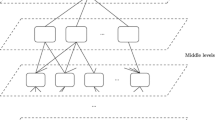Abstract
In this chapter, granular computing is used to process the Web information. The main result is that the human thinking inside a document set can be represented by a polyhedron; more general cases are discussed. A polyhedron is a subset of Euclidean space that supports a combinatorial structure, called simplicial complex. From the granular computing point of view, a simplicial complex is a special form of the granular model, in which the granular structure satisfies the closed condition (geometric concept). It is important to note that it is equivalent to the Apriori principle (data mining concept). A point in such a polyhedron represents a human thought. Each simplex represents a concept. A maximal simplex is a primitive concept. A connected component represents a complete concept. The totality of these concepts is called the basic knowledge.
Preview
Unable to display preview. Download preview PDF.
Similar content being viewed by others
References
Agrawal, R., Srikant, R.: Fast Algorithms for Mining Association Rules. In: Proc. 20th VLDB Conference (1994)
Bairamian, S.: Goal Search in Relational Databases, Thesis, California State University at Northridge (1989)
Brewer, D.C., Nash, M.J.: The Chinese Wall Security Policy. In: IEEE Symposium on Security and Privacy, Oakland, pp. 206–214 (May 1988)
Chu, W., Chen, Q.: Neighborhood and Associative Query Answering. Journal of Intelligent Information Systems 1, 355–382 (1992)
Dubois, D., Prade, H.: Putting Rough Sets and Fuzzy Sets Together. In: Slowinski, R. (ed.) Decision Support by Experience - Application of the Rough Sets Theory, pp. 203–232. Kluwer Academic Publishers, Dordrecht (1992)
Lin, T.Y.: Granular Computing II: Infrastructures for AI-Engineering. In: Proceedings of 2006 International Conference on Granular Computing, May 10-12, Atlanta, Georgia, USA (2006)
Lin, T.Y.: Granular Computing: Examples, Intuitions and Modeling. In: Proceedings of 2005 IEEE International Conference on Granular Computing, July 25-27, Beijing China, pp. 40–44 (2005)
Lin, T.Y., Chiang, I.-J.: A Simplicial Complex, a Hypergraph, Structure in the Latent Semantic Space of Document Clustering. International Journal of Approximate Reasoning 44, 55–80 (2005)
Lin, T.Y.: Granular Computing: Structures, Representations, Applications and Future Directions. In: Wang, G., Liu, Q., Yao, Y., Skowron, A. (eds.) RSFDGrC 2003. LNCS (LNAI), vol. 2639, pp. 16–24. Springer, Heidelberg (2003)
Lin, T.Y.: Granular Computing on Binary Relations I: Data Mining and Neighborhood Systems. In: Skowron, A., Polkowski, L. (eds.) Rough Sets In Knowledge Discovery, pp. 107–120. Springer, Heidelberg (1998)
Lin, T.Y.: Granular Computing on Binary Relations II: Rough Set Representations and Belief Functions. In: Skowron, A., Polkowski, L. (eds.) Rough Sets In Knowledge Discovery, pp. 121–140. Springer, Heidelberg (1998)
Lin, T.Y.: Topological and Fuzzy Rough Sets. In: Slowinski, R. (ed.) Decision Support by Experience - Application of the Rough Sets Theory, pp. 287–304. Kluwer Academic Publishers, Dordrecht (1992)
Lin, T.Y., Huang, K.J., Liu, Q., Chen, W.: Rough Sets, Neighborhood Systems and Approximation. In: Proceedings of the Fifth International Symposium on Methodologies of Intelligent Systems, October 25-27, Knoxville, Tennessee, pp. 130–141 (1990)
Lin, T.Y.: Chinese Wall Security Policy – An Aggressive Model. In: Proceedings of the Fifth Aerospace Computer Security Application Conference, Tuscon, Arizona, pp. 282–289 (December 1989)
Lin, T.Y.: Neighborhood Systems and Relational Database. In: Proceedings of 1988 ACM Sixteen Annual Computer Science Conference, 725 (abstract) (1988)
Munkres, J.: Topology, 2nd edn. Prentice-Hall, Englewood Cliffs (2000)
Pawlak, Z.: Rough Sets. Theoretical Aspects of Reasoning about Data. Kluwer Academic Publishers, Dordrecht (1991)
Polya, G.: How to Solve It, 2nd edn. Princeton University Press (1957)
Salton, G., McGill, M.J.: Introduction to Modern Information Retrieval. McGraw-Hill, New York (1986)
Salton, G., Buckley, C.: Term-weighting approaches in automatic text retrieval. Information Processing and Management 24(5), 513–523 (1988)
Sierpinski, W., Krieger, C.: General Topology. University of Toronto Press (1952)
Spanier, E.: Algebric Topology. McGraw-Hill, New York (1966)
University of California, Irvine, Knowledge Discovery in Databases Archive. [WWW Document] (2006), http://kdd.ics.uci.edu/
WordNet Similarity 1.02 Stoplist. [WWW Document] (visited August 10, 2005), http://search.cpan.org/src/TPEDERSE/WordNet-Similarity-1.02/samples/stoplist.txt
Zadeh, L.A.: Fuzzy Sets and Information Granularity. In: Gupta, M., Ragade, R., Yager, R. (eds.) Advances in Fuzzy Set Theory and Applications, pp. 3–18. North-Holland, Amsterdam (1979)
Zadeh, L.A.: Towards a Theory of Fuzzy Information Granulation and Its Centrality in Human Reasoning and Fuzzy Logic. Fuzzy Sets and Systems 19, 111–127 (1997)
Zadeh, L.A.: Some Reflections on Soft Computing, Granular Computing and Their Roles in the Conception, Design and Utilization of Information/Intelligent Systems. Soft Computing 2, 23–25 (1998)
Zadeh, L.A.: Some Reflections on Information Granulation and Its Centrality in Granular Computing, Computing with Words, the Computational Theory of Perceptions and Precisiated Natural Language. In: Lin, T.Y., Yao, Y.Y., Zadeh, L.A. (eds.) Data Mining, Rough Sets, and Granular Computing, pp. 3–20 (2002)
Author information
Authors and Affiliations
Editor information
Rights and permissions
Copyright information
© 2007 Springer-Verlag Berlin Heidelberg
About this paper
Cite this paper
Lin, T.Y.(.Y.)., Vo, MH. (2007). Granular Computing: Modeling Human Thoughts in the Web by Polyhedron. In: Zhong, N., Liu, J., Yao, Y., Wu, J., Lu, S., Li, K. (eds) Web Intelligence Meets Brain Informatics. WImBI 2006. Lecture Notes in Computer Science(), vol 4845. Springer, Berlin, Heidelberg. https://doi.org/10.1007/978-3-540-77028-2_8
Download citation
DOI: https://doi.org/10.1007/978-3-540-77028-2_8
Publisher Name: Springer, Berlin, Heidelberg
Print ISBN: 978-3-540-77027-5
Online ISBN: 978-3-540-77028-2
eBook Packages: Computer ScienceComputer Science (R0)




